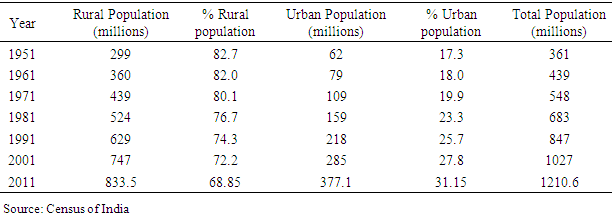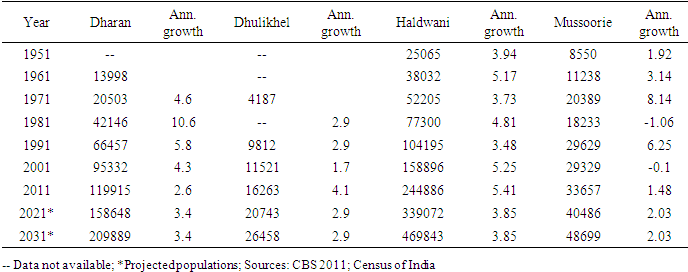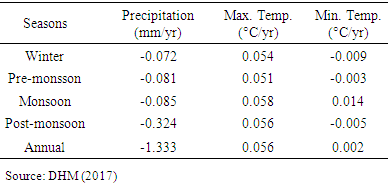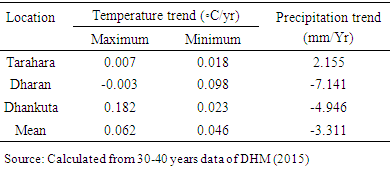-
Paper Information
- Paper Submission
-
Journal Information
- About This Journal
- Editorial Board
- Current Issue
- Archive
- Author Guidelines
- Contact Us
Resources and Environment
p-ISSN: 2163-2618 e-ISSN: 2163-2634
2019; 9(1): 9-18
doi:10.5923/j.re.20190901.02

Urban Water Security Challenges in the Nepal and Indian Himalaya in the Context of Climate Change
Roshan M. Bajracharya1, Ngamindra Dahal1, Kaustuv R. Neupane1, Vishal Singh2, Riyan Habeeb2
1Southasia Institute of Advanced Studies, Kathmandu, Nepal
2Center for Ecology Development and Research, Dehradun, India
Correspondence to: Roshan M. Bajracharya, Southasia Institute of Advanced Studies, Kathmandu, Nepal.
| Email: |  |
Copyright © 2019 The Author(s). Published by Scientific & Academic Publishing.
This work is licensed under the Creative Commons Attribution International License (CC BY).
http://creativecommons.org/licenses/by/4.0/

South Asia is home to over a fifth of the world’s population that is increasingly becoming concentrated in urban and peri-urban areas. Small to medium-sized cities in the Himalayan regions of Nepal and India are undergoing rapid urbanization. The increasing population, changing lifestyles, economic status of people, and effects of climate change are all contributing to the ever-growing water shortages, leading to a situation of water insecurity in the region. Four cities, namely, Dhulikhel and Dharan in Nepal, and Mussoorie and Haldwani in India were chosen for study as representative of urban areas in the low to medium elevation in the Himalaya that are dependent on springs, streams, rivers and groundwater for meeting domestic and commercial water needs. The present situation and future prospects suggest that ensuring adequate supplies of acceptable quality water for these cities will become ever more challenging in the decades to come unless city specific climate adaptive and equitable water supply measures are employed effectively. Moreover, certain segments of city dwellers face greater difficulties in gaining access to potable water due to socio-cultural and economic factors. Therefore, to achieve sustainable, equitable and climate resilient water management, measures such as, protection of critical urban water zones, stream bank and gully stabilization, water harvesting and groundwater recharge will be needed along with augmentation of infrastructure, increased storage capacity, appropriate policies and institutional arrangements at local, state, and national levels for effectively addressing the issues of equitable water access to each of the households in the cities.
Keywords: Hill towns, Sustainable, Climate resilient, Adaptive management
Cite this paper: Roshan M. Bajracharya, Ngamindra Dahal, Kaustuv R. Neupane, Vishal Singh, Riyan Habeeb, Urban Water Security Challenges in the Nepal and Indian Himalaya in the Context of Climate Change, Resources and Environment, Vol. 9 No. 1, 2019, pp. 9-18. doi: 10.5923/j.re.20190901.02.
Article Outline
1. Introduction
- The 21st century is witness to one of the most significant challenges of modern times, namely management of water resources, as a result of increasing population, rapid economic growth and development, and expansion of irrigated agriculture in the 20th century (Gleick 2000). The populations of most countries will continue to grow, which will result in serious implications for food security, energy production and urban water management, posing serious threats on the existing water resources. As per Eigenbrod et al (2011), globally in the year 1900, only 220 million (13 percent) people lived in urban areas, which increased to 3.2 billion (49 percent) by 2005. It is expected that the population living in urban areas would increase to 4.9 billion (60 percent) by 2030. Urbanization has the potential to improve well-being of the societies; although only half of the population lives in urban areas, their contribution to the world domestic product is more than 80 percent; however, the impacts on ecosystem services will be complex and variable (Gleick, 2003; Fitzhugh and Richter, 2004). In a study by Eigenbrod et al. (2011) in the UK, modeling of urban land changes considering a 16 percent increase in population by 2031 indicated notable impacts on flood mitigation, agricultural production and carbon storage with competing influences due to urban sprawl versus densification.Another study in the US mid-west showed urbanization to adversely impact cities capacities to regulate climate and adapt to flooding (due to increased runoff), while causing decreased net primary productivity through removal of croplands, grasslands and forests (Schneider et al., 2012). According to Gunerlap et al. (2013), while the most rapid urbanization will be in the mid-latitudes of Africa, South America and China, the impacts on biodiversity, food security and ecosystem services is likely to be significant globally. In the North China Plains, urbanization was noted to significantly decrease water conservation, nutrient cycling, gas regulation and organic production (Song and Deng, 2015). As the largest continent of the Earth in terms of both land area and population, Asia is home to over half the world’s population (Kramer, 2016; Reuters, 2016). South Asia, is inhabited by more than 20 percent of the world population, i.e., more than 1.6 billion people (Surie, 2015) and is facing acute seasonal water shortages. Major cities in India, Nepal, Bangladesh, Pakistan and other South Asian countries have, over the past few decades, become water-stressed and hundreds of millions of people receive only intermittent water supplies or face long hours of queuing to obtain drinking water (Dizikies, 2016; Surie, 2015). Rural and urban areas of the Nepal and Indian Himalayan region are increasingly suffering from water crises, due to rapid urbanization, economic development and changes in climatic conditions. This paper examines the factors leading to water stress in the central and western Himalaya of Nepal and India, respectively, in view of the potential future impacts of climate change. We discuss urban water security issues in the context of recent changes in population, socio-economic and cultural dimensions, offer comparative analyses of the study cities with trends of population and climate, as well as, potential strategies to reduce water shortages and measures to achieve sustainable, equitable and climate change adaptive water management in the region.
2. Population Growth Trends and Water Demand/Supply
- Since the early 1900s, the populations of the nations of South Asia have grown exponentially, multiplying 4- to 5-fold in less than a century (Figures 1 and 2). While the overall population growth rate peaked in the late 1970s to early 1980s, the urban populations in Nepal and India continue to grow at accelerating rates due to an influx from surrounding rural areas (KMPG, 2010; Regmi, 2014). The general rural and urban population trends of cities in Nepal and India are shown in Tables 1 and 2. While the rural populations are expected to remain nearly constant or decrease slightly, the urban population is likely to grow by about 60 percent by 2050 (Asia Society, 2009).
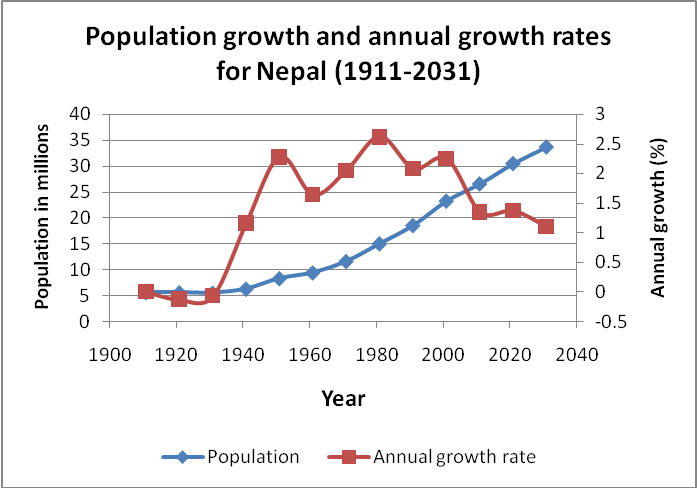 | Figure 1. Population and annual growth trends in Nepal from 1911 to 2031. Source: UNFPA (2017) |
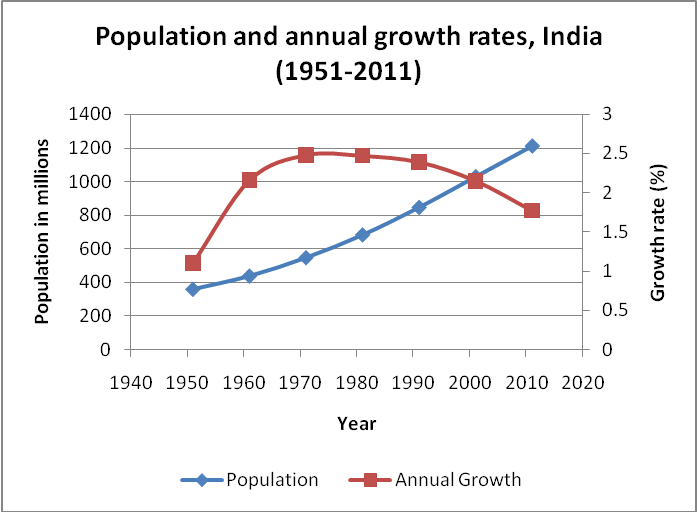 | Figure 2. Population and annual growth rates for India (1951 to 2011). Source: Census of India |
|
|
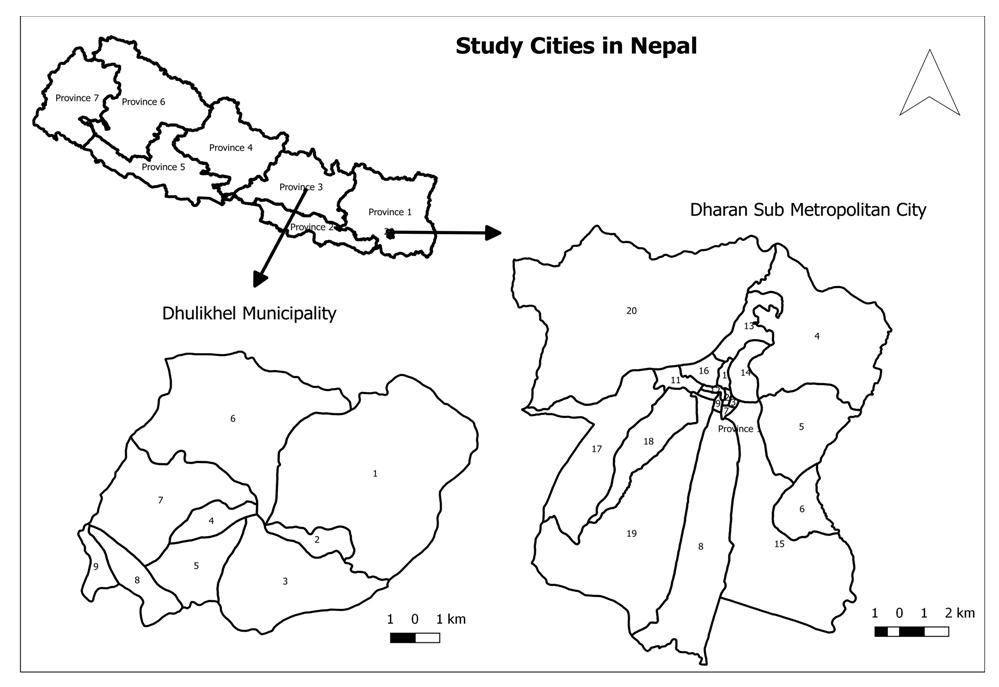 | Figure 3. The study locations in central and eastern Nepal |
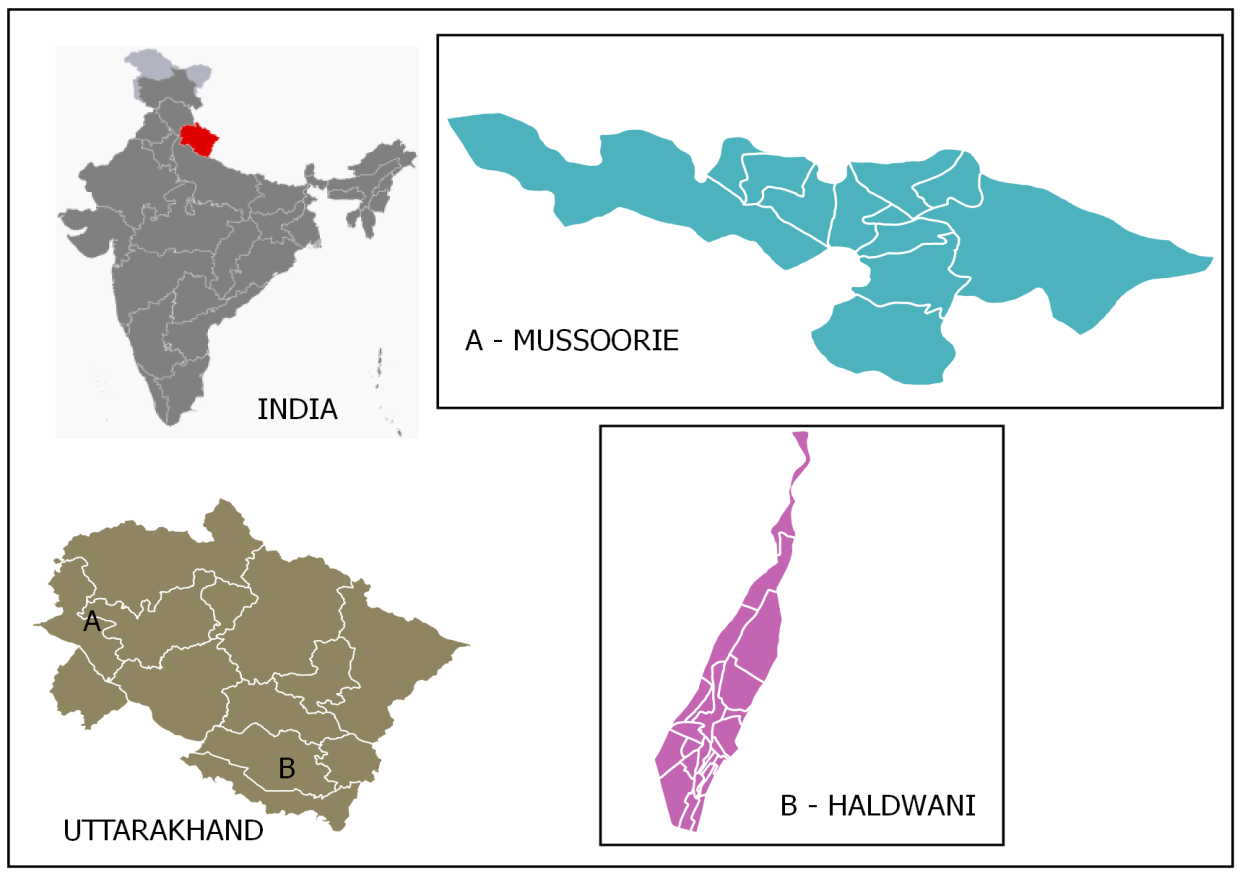 | Figure 4. Location of the study cities in northwestern India |
|
3. Water Security and Management Issues
- With a growing urban population, cities in south Asia will face ever-growing demand for safe water. India supports 16 percent of the world’s population and about 20 percent of the total livestock population of the world, but has only 2.5 percent of the world’s land area and 4 percent of the world’s water resources (Asia Society, 2009; KPMG, 2010). In contrast, Nepal has much lower population density than India and higher per capita availability of water resources, yet many parts of the country lack safe water supplies and distribution, especially in urban areas. At the national scale, the demand for water in India is projected to overtake the availability in the near future, with overall demand growing by 20 percent, of which, industrial requirements are projected to double, while domestic and irrigation requirements will grow by 40 and 14 percent respectively (KPMG, 2010).One of the Sustainable Development Goals, namely SDG 6, is to ensure availability and sustainable management of water and sanitation for all. The United Nations University (2013) defines water security as “the reliable availability of an acceptable quantity and quality of water for production, livelihoods and health, coupled with an acceptable level of risk to society of unpredictable water-related impacts”. Furthermore, the Asian Water Development Outlook compiled by ADB (2016) describes five key dimensions to national water security, namely, household water security, economic water security, urban water security, environmental water security, and resilience to water-related disasters. With the exception of economic water security, the countries of south Asia consistently rank at the bottom with regard to national water security. According to the ADB Asian Water Development Outlook 2016 report, India has the highest groundwater extraction rate globally of about 250 cubic kilometers per year. India also has the highest non-revenue water, i.e., 50% of leakage and theft, among the countries of south Asia (ADB 2016). Most of the freshwater and surface water sources in this region have already been tapped and climate variability is likely to exacerbate the situation by causing changes in temperature, precipitation, evaporation and increases in the frequency of floods and droughts.It is evident that water management in the 21st century will need to look beyond major construction projects and large-scale regional water transfers to soft-path approaches involving improved efficiency of water use, pricing to manage demand, reallocation among users, restoring ecological health, reclaiming wastewater, etc. (Gleick, 2000; 2003). A variety of good practices and lessons for urban water management have been put forth in a comprehensive study covering several South and South-east Asian countries (Chiplunker et al., 2012). These include, among others, proper regulation, cross-agency cooperation, linkages with all stakeholders, a corporate (but not necessarily private ownership) approach to water management, improved efficiency and effectiveness of service delivery and sound financial as well as human resources management. Another report examining global good practices for urban water management (NIUA, 2015) highlights, in addition to good governance and utility reforms, an integrated approach to managing water supplies including drainage and wastewater, as well as, reducing leakage losses, non-revenue water, and appropriate pricing or water tariffs.
4. Key Causes of Water Insecurity in the Himalayan Cities
- Clearly, the single most important cause of water scarcity is the rapid population increase in urban areas. In the study cities, of Nepal and India, population growth and interlinked factors such as migration from rural areas, tourist influx, unscientific construction and degradation of recharge zones are causing serious threats to water security, disasters and pollution. While current average national population growth rate is about 1.35 percent in Nepal and about 1.2 percent in India, in the study sites located in the hill areas of central and western Himalaya, the projected population growth ranges from 2.03 to 3.85 percent (Table 3). As prospects for meeting food and livelihood requirements become increasingly difficult to meet through agriculture, lack of basic facilities and frequent disasters the, young adults, are moving from rural areas to the cities. For the youth, urban centers offer greater opportunities of education, employment and recreation; hence they are increasingly attracted to cities. Apart from this, the state government of Uttarakhand has focused more on secondary and tertiary sectors of economy since its formation in 2000. These sectors are highly urban in nature, which is also a reason why more and more people from the rural areas are moving towards the urban areas in search of new opportunities created. Additionally, in villages of both India and Nepal, there is a significant proportion of the rural population, generally the working-age male members of the communities, who leave during the dry season for wage labour and other types of employment in urban areas. Another major reason for observed decreases in water quantity in steams, springs and ground water reserves in the study areas is land use change. Analysis of land use changes in Uttar Pradesh India (western Himalaya) by Pant et al. (2000) revealed a 27 percent decline in forest cover (mainly oak forest) with notable degradation of forest vegetation accompanied by expansion of settlements. The resulting impacts were thought to be adverse effects on agroecosystems leading to decreased productivity (Pant et al., 2000). Similarly, from an extensive review of land cover changes in Nepal, Paudel et al. (2016) found that cropland has increased by 13 percent while forest area fluctuated considerably decreasing by about 4.6 percent over the past 50 years. However, more notable was the substantial changes in urban land use and land cover over the past 30 years (Paudel et al., 2016). With increasing built-up areas and reduction in forest and natural vegetation, rainfall has less opportunity to infiltrate into the ground and rapidly runs off outside the catchments of the cities to downstream areas. Due to increased events of high intensity rainfall and torrential storms as a result of climate change observed over the last few decades, the downstream areas are affected by flood-related disasters every year both in India and Nepal. The dual predicament as a consequence of climate change leads to sudden large flow volumes during severe storm events, often leading to localized disasters and flooding and damage in downstream areas. Similarly winter rainfall deficit and pre-monsoon droughts have become more common hampering recharge capacity of aquifers leading to low discharge from springs and streams and low flows in the rivers. Apart from the above-mentioned biophysical factors, changes in life-styles, poor governance, outmoded infrastructure, lack of storage facilities and poor awareness levels are aggravating the problem. In the recent past (2-3 decades earlier), cities like Dhulikhel and Dharan primarily had common public taps rather than piped water to individual households. This typically limited the use of water as it would be available only once or twice a day and each household had to carry water in containers to their homes. However, with modern technologies, such as, flushing toilets and shower faucets, the demand for piped water supply to each household has increased. This along with changing hygiene habits (bathing and washing) of local people which have been gradually influenced by education and western culture have led to a dramatic increase in per capita water consumption. A key driver of lifestyle and technology-related changes in the study cities is the improvement in economic status of a majority of the population. There is a growing lower-middle and middle class segments of these urban areas. With affluence, an increase in demand for new uses of water, such as, washing vehicles, watering gardens and lawns, and more frequent cleaning of homes tends to occur. All of these additional uses of water lead to substantially higher per capita water consumption. Life style choices are a key concern in India; however, the present study sites in India face challenges with regard to both water quantity and quality especially during the peak dry season. In the cases of Mussoorie and Haldwani the problem stems from improper implementation of policies and age old infrastructure, while the government of India norms for cities is to provide 135 liters of water per capita, both cities fail to do so. This is largely because of lack of storage capacity, leaky pipelines and lackluster implementation of policies such as rain water harvesting, metering, encroachments and unscientific development resulting in low discharge and disappearance of springs and neglect towards drainage lines and canals. The final factor that is beginning to influence water availability, and can be expected to impact future water supply, is a change in climatic pattern. Studies examining climatic trends across the Himalayan region indicate that mean air temperatures have increased by about 0.08 to 0.18 C per decade, hence most parts of the Hindu Kush Himalaya (HKH) have experienced a warming trend over the past 100 years (Ren et al., 2017; You et al., 2017). Temperature extremes have been seen to increase during the period from 1961 to 2015, with a decrease in the number of cold nights, cold days and frost, and concomitant increase in warm days and nights (Sun et al., 2017). With regard to precipitation, northwestern parts of the HKH had a significant increase in precipitation (5.28 percent per decade) with more precipitation days, while eastern parts have seen a declining trend in precipitation days over the past 50 years (Ren et al., 2017). In terms of predictions for the future, assessments using CORDEX South Asia regional climate models suggest warming for the hilly sub-regions of Karakoram and northwestern Himalaya of 5.4 C in the winter and 4.9 C during the summer monsoon season by the end of the 21st century under the high-end (RCP8.5) emissions scenario (Sanjay et al., 2017). Precipitation during the summer monsoon is predicted to increase by 22 percent in the southeastern Himalaya, but western parts of the Himalaya are predicted to become drier under this carbon intensive scenario (Sanjay et. Al., 2017; Choudhary and Dimri, 2017). Weather data collected over 3-4 decades for the study cities indicated notable trends in temperature and precipitation patterns. The overall climatic trends for Nepal as a whole indicate only a slight increase in maximum temperatures and a slight decrease in annual total precipitation. However, a notable trend is the reduction in dry season (post-monsoon) precipitation, which includes snowfall during the winter (Table 4). A detailed analysis by DHM (2017) reported that the number of cool days and nights were generally decreasing while warm days and nights increasing across most districts in Nepal. Also, very wet days were decreasing although consecutive wet days showed an increasing trend in northern districts of Nepal (DHM, 2017).
|
|
|
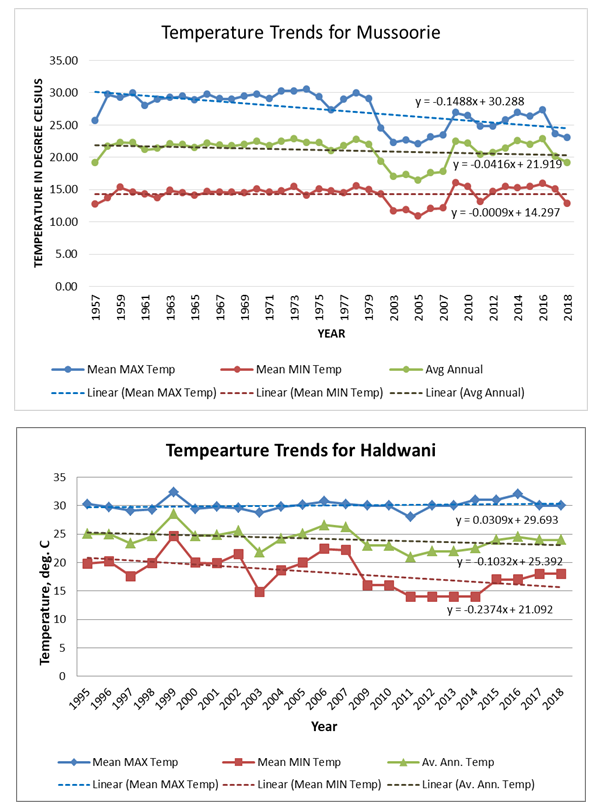 | Figure 5. Temperature trends for Mussoorie and Haldwani, India |
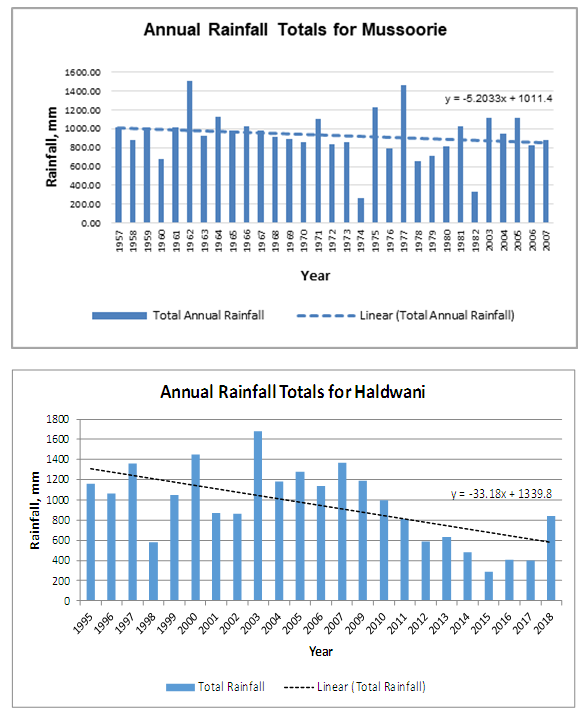 | Figure 6. Precipitation trends for Mussoorie and Haldwani |
5. Comparative Analysis
- The four cities chosen for this study in both Nepal and India have contrasting geographic and demographic settings. While Dhulikhel and Mussoorie are both hill-top towns with relatively small populations, Dharan and Haldwani are cities located at the foot of the lower hills and have larger populations compared to the former. The hill-top towns, however, have a considerable seasonal influx of tourist populations causing a sharp increase in the demand for water during these times, while the latter have a more stable population with less fluctuation due to temporary visitor numbers. Moreover, Haldwani and Dharan have more commercial and industrial activity, as well as, generally higher per capita water demand due to their location in a warmer physiographic zone than the hill towns.Although the corresponding study cities in Nepal and India (Dhulikhel with Mussoorie and Dharan with Haldwani) have a number of similarities, there are also distinct differences. While Dhulikhel is similar to Mussoorie in its physiographic features, the populations are considerably different with the latter being higher. Moreover, Mussoorie has a significantly higher seasonal influx of tourists and visitors than Dhulikhel, thus, it has a greater seasonal fluctuation of water demand. Thus, for hill top towns, protection of water source areas, enhancing rainwater harvesting, and increased storage capacity for the dry season are key management options. Likewise, while both Dharan and Haldwani are commercial cities, the latter is substantially bigger in population and areal extent. Haldwani also has a larger squatter (slum) population than Dharan which faces greater challenges to meet water needs. These towns located at the foot of the hills that rely more on ground water should place emphasis on groundwater recharge and upstream conservation measures to prevent flooding. In addition, appropriate policy measures are required to deal with adequate water supply and quality in slum areas.
6. Potential Strategies to Meet Future Challenges
- Rapidly growing cities in the Himalayan regions of India and Nepal are already facing severe water shortages as well as sub-optimal water quality. Clearly, the situation is bound to become worse in the future due to increasing populations, changing lifestyles, and the compounding effects of climate change unless effective action and policy initiatives are taken in a timely manner. For towns and cities situated in hilly areas or at the foot of mountain ranges, protection of the upstream water sources and precautions against potential torrential flows, flashfloods and landslides are essential. Measures to simultaneously achieve these goals must include watershed conservation practices, such as, contour trenches, recharge ponds, stream bank and gully protection, vegetation maintenance around critical water sources, and community or individual water harvesting structures. Ground water is also rapidly becoming a major source of water for municipalities and communities in the region resulting in steadily dropping water table levels. Therefore, it is essential that the ground water reserves be replenished through recharge so as to prevent its decline beyond the possibility of extraction. Apart from structural measures, management challenges that face the municipalities of these towns include improving the efficiency and effectiveness of services through enhanced capacity of the staff, appropriate tariffs, water utilities reform, reduction of leakage and elimination of non-revenue water (NIUA, 2015; Raj, 2013; Sastry, 2006). Furthermore, cities that have a sizeable marginal population living in squatter settlements or slums need to address provision of the availability and quality of water for these communities. They need either to be brought into the mainstream enabling access to the municipal water supply or they should be assisted to develop community water harvesting or extraction structures. These could include a series of conservation ponds and collection trenches (in hilly areas) or tube wells to access ground water. Appropriate policy formulation and adoption at the local, state, and national levels are required for effective implementation of the above measures and strategies. Table 7 provides an overview of the suitability of potential mitigation options for the various study cities.
|
7. Researchable Gaps and Priorities
- It is evident that water demand will continue to grow in the rapidly expanding urban areas of south Asia and the Himalayan cities investigated in this study. In order to better manage supply, there is a need for clearer understanding of the demand from different sectors and segments of the local population. Therefore, projecting demands for water resources by various economic sectors, as well as, water use and needs of different ethnic populations in these cities and regions would be of use to planners and water managers. In addition, some ethnic or demographic groups stand to face greater water insecurity as a consequence of their position or economic status in society. Such water and sanitation vulnerable groups, like squatter communities and landless poor families, would require special attention and appropriate policies for mainstreaming, particularly in view of public health issues (Hess et al., 2012). Moreover, the ever-growing demand for water, especially near urban areas, will have adverse impacts on aquatic ecosystems requiring a balanced approach for meeting human and ecosystem needs (Fitzhugh and Richter, 2004; Fitzhugh et al., 2012). Undoubtedly, climate change will have major implications for water resources and supply, and research focusing on its impacts on springs, streams and groundwater sources need to be conducted so as to anticipate and be better prepared for the changes. Finally, policy and institutional arrangements to address the above water-related challenges and ensure implementation of sustainable, equitable and climate adaptive water management strategies are imperative.
8. Conclusions
- Small to medium-sized cities in the Himalayan regions of India and Nepal are undergoing rapid expansion, population growth and economic transformation. The increasing population, changing lifestyles, economic status and impacts of climate change are all contributing to ever-growing water demands and insufficient supplies leading to a situation of water insecurity in the region. The four study cities, namely, Dhulikhel and Dharan in Nepal, and Mussoorie and Haldwani in India are representative of urban areas in the foothills of the Himalaya that are dependent on springs, streams and groundwater for meeting domestic and commercial water requirements. The present status and future scenario suggests that procuring adequate supplies of acceptable quality water for these cities will become ever more challenging in the decades to come. In addition, some segments of society face greater difficulties in gaining access to potable water due to socio-cultural and economic factors. Therefore, ensuring sustainable, equitable and climate resilient water management will require measures, such as, source area protection, stream bank and gully stabilization, water harvesting and groundwater recharge along with utilities reforms, leakage and non-revenue water reduction, and suitable water pricing. Furthermore, appropriate policies and institutional arrangements at local, state, and national levels will be needed for effectively addressing the water-related issues and problems. As this analytical review was based on a limited cross-section of four cities in the region, a more in-depth investigation covering a larger number of cities and bigger population could be useful to elucidate the range of issues and complexities of water insecurity in the Himalayan region.
ACKNOWLEDGEMENTS
- The authors gratefully acknowledge IDRC for support of this study through its Cities and Climate Change initiative.
 Abstract
Abstract Reference
Reference Full-Text PDF
Full-Text PDF Full-text HTML
Full-text HTML
